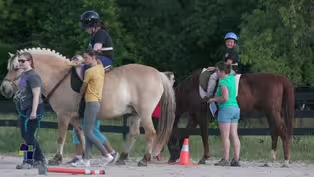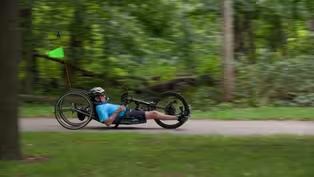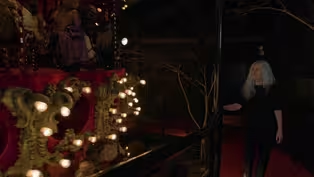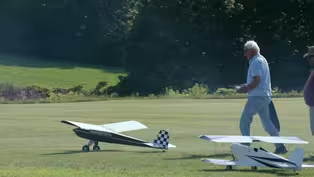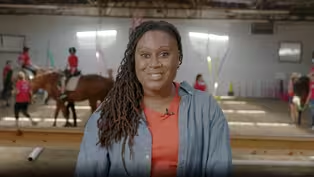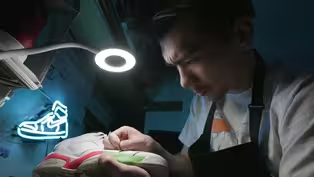
Great Strides
Season 9 Episode 1 | 26m 48sVideo has Closed Captions
Angela heads to the stables at LifeStriders to learn about equine therapy.
Angela Fitzgerald visits LifeStriders in Waukesha, a non-profit offering equine therapy for kids and people with special needs. We also meet the members of the Lodi Area Radio Control Club, a Madison professor using insects to create art, a handcyclist in Wauwatosa and a modern day cobbler restoring sneakers.
Problems playing video? | Closed Captioning Feedback
Problems playing video? | Closed Captioning Feedback
Wisconsin Life is a local public television program presented by PBS Wisconsin
Funding for Wisconsin Life is provided by the Wooden Nickel Fund, Mary and Lowell Peterson, A.C.V. and Mary Elston Family, Obrodovich Family Foundation, Stanley J. Cottrill Fund, Alliant Energy, UW...

Great Strides
Season 9 Episode 1 | 26m 48sVideo has Closed Captions
Angela Fitzgerald visits LifeStriders in Waukesha, a non-profit offering equine therapy for kids and people with special needs. We also meet the members of the Lodi Area Radio Control Club, a Madison professor using insects to create art, a handcyclist in Wauwatosa and a modern day cobbler restoring sneakers.
Problems playing video? | Closed Captioning Feedback
How to Watch Wisconsin Life
Wisconsin Life is available to stream on pbs.org and the free PBS App, available on iPhone, Apple TV, Android TV, Android smartphones, Amazon Fire TV, Amazon Fire Tablet, Roku, Samsung Smart TV, and Vizio.
Providing Support for PBS.org
Learn Moreabout PBS online sponsorship- The following program is a PBS Wisconsin original production.
- Angela: Coming up on Wisconsin Life: a professor using insects to create art, a hand cyclist with a passion for pedaling, a club taking to the skies without leaving the ground, and a modern-day cobbler.
It's all ahead on Wisconsin Life!
♪ ♪ - Funding for Wisconsin Life is provided by Lowell and Mary Peterson, Alliant Energy, A.C.V.
and Mary Elston family, Focus Fund for Wisconsin Programs, and Friends of PBS Wisconsin.
- Hi, I'm Angela Fitzgerald and this is Wisconsin Life.
We're saddling up to check out LifeStriders, a non-profit offering nature-based therapy to families and individuals with special needs.
Sitting on 23 acres in Waukesha, the organization works with a team of therapists, counselors, and volunteers to offer holistic support.
For almost two decades, LifeStriders has offered equine-assisted therapy, social skill groups, and work readiness programs at low or no cost.
The goal for all of these programs is the same: to transform the lives of the community members it serves.
It takes the help of 500 volunteers of all ages to keep the farm running, from caring for the space to assisting with therapy rides.
Of course, the horses play a huge part, too.
All to support the mission to provide life-enhancing experiences.
Before we learn more about LifeStriders and their impact, let's get out and around the state.
- We now head to Spring Green to catch up with the professor who constructs works of art crawling with creativity.
[mystic instrumental] - Jennifer Angus: My first reaction when I visited House on the Rock was, "This is crazy!"
This place is full of wonder.
I do draw inspiration.
I try not to come too often because if I came too often, then I think it would cease to be magical.
Interestingly enough, people say virtually the same thing to me about my exhibitions.
They say, "Oh, this is so magical."
My name is Jennifer Angus, and I'm an artist and professor at the University of Wisconsin-Madison.
[piano music] Well, I'll begin by answering the most common questions I get asked.
"Are the insects real?"
Yes, indeed, they are.
"Is this their natural color?"
Because it's amazing, the range of colors from pinks to blues to the shiny greens and it is their natural color.
I always say, "I'm crazy, but I'm not crazy enough to paint them all, too."
The very first installation I did with insects was in a downtown Toronto storefront gallery.
And when I had completed putting my pattern in insects upon the wall, I, of course, was hanging around the gallery and people were putting their face up to the glass and I could hear people saying, "Well, I see they've put up a new wallpaper, but I don't see the art."
And they walked in and walked up to the wall, and then, literally, I watched them take a step back as they realized that that pattern, that wallpaper is made of insects.
I really feel like I channel that Victorian aesthetic of, "There is no such thing as too much."
[playful string music] I think that I probably have about 20,000 insects.
So, when the insects come to me, they're not necessarily ready to go onto the wall.
They are on a piece of cardboard.
They are curled up with their legs tucked in or their wings in and then, there's a piece of cellophane and it's stapled all around the edges.
Before I can even think about putting the insects on the wall, they have to be spread.
And the first step is to relax them, which essentially means to rehydrate them.
It's a humidity chamber, which sounds very fancy.
It's actually a Tupperware container with some water in the bottom, a piece of foam, and the insects float on the foam.
I put the lid on.
And depending on the size of the insect, it will take two, three, perhaps four days until they soften up.
Once that happens, I can take them out.
I can move their wings or their legs and pin them into position.
And then, they dry for another two to three days, and they will stay that way.
I often say that cicadas are the meat and potatoes of my exhibitions because they are so hardy.
They really stand up to the wear and tear, and they're also quite large.
The biggest one has an eight-inch wingspan.
Most of the insects that I use are tropical species.
When at all possible, I use farmed species, and people are also surprised to hear that, but there are development projects in Papua New Guinea, in Madagascar, in Malaysia, in which people are raising insects sometimes for food, but also for collectors.
Insects, like many animals these days, are threatened by urban and suburban sprawl, by climate change.
And what is absolutely heartbreaking is to hear the stories of the Amazon rainforest being cut down-- the very lungs of our planet.
So, for anyone who walks into the exhibition and feels upset how many hundred insects died for this exhibition, I would say, "You feel upset?
So, do I."
This is what I'm doing to start a conversation or be part of the conversation.
I first came to insects because of their beauty.
But as I continue to work with insects, I'm just so impressed with them.
E.O.
Wilson, the famous biologist who studied ants, said, "They're the little things that make the world run."
So, for me, and many artists I know, we walk around museums and we simply stop by the work that moves us.
The first thing I'm looking for is that feeling of wonder-- that 'wow' moment.
One of the things I want to do is create a space in which people can escape.
I've really tried hard to make these spaces that are somewhat magical.
♪ ♪ We travel to Wauwatosa to pedal with the hand cycling enthusiast, raising money for a worthy cause.
♪ ♪ - John Haupt: You're basically in a prone position.
Your head's slightly elevated, and your sole source of drive comes from your arms.
Whoa!
- Hand cycling is a passion for John Haupt.
- I ride lots of trails around Milwaukee.
There's really nowhere that I don't ride.
It's been a great thing for me.
It's very relaxing.
I mean, because I just, very-- It's soothing.
It's therapeutic.
It's freeing.
The hills become part of the challenge.
- The challenge for John started as a teenager.
For more than 50 years, he has battled multiple sclerosis.
- When I was first hospitalized, we had no idea what it was.
So, oddly, it was kind of a relief to just know what it is because then I could deal with it.
I always say your nerves are like your body's electrical system and if somebody throws a wrench into your electrical box, things are going to go haywire.
And that's what happens.
In those days, we're talking the 1970s, they used to tell us that, "You shouldn't participate.
You shouldn't be too physically active."
- Angela: Today, the science has changed and encourages those with MS to stay active.
- And I know that to be true.
And I had the opportunity to get on a wakeboard, which I'd never done before.
[motor boat revs] I got up and got around the lake a couple times on the second try.
[cheering] It was fantastic.
For people who are disabled, either from spinal cord injuries, MS, whatever, there's a ton of opportunity out there.
All right, here we go!
You can go downhill skiing.
Whoo-hoo!
It doesn't fix your MS.
It doesn't make your MS... better but it maximizes what you have.
- What John has is motivation.
- If MS needs a poster boy, I'm more than willing to be it.
[chain gears clinking] - He also goes the extra mile to support MS research.
- I know that we can have a world free of MS. And I know that with your help we're going to beat this thing.
- Each year... - Hey, hey, hey!
Johnny's big push is back.
- For nearly a decade... - Hi, there.
Coming to you from the Lake Country Trail.
- John has produced and starred in these fundraising videos.
- But MS doesn't take vacations.
So, I'm pushing on in the 2021 MS Best Damn Bike Tour, and I need your help.
- So far, he's raised more than $150,000.
- If it results in more MS progress, research, then, yeah, I'll be-- I'll be the guy.
- John is also the guy who brought hand cycle racing to Wisconsin.
♪ ♪ - So, I became a big fan of the bike racing here in Milwaukee.
- And was instrumental in getting hand cycling included in the Tour of America's Dairyland Road Race.
- I did a kind of grassroots recruiting of riders from around the country.
This year we had 25 riders from 15 states.
I'm the self-appointed hand cycle director.
- Now, the racing world has taken notice.
- I think we're one of the fastest growing hand cycle race in the country.
Yeah, it's become very popular.
It's pretty remarkable what they can do.
For John, hand cycling is liberating and empowering.
I'm not the fastest guy in the race, or even in town, or even in Wisconsin.
It takes devotion, a single-minded devotion.
It keeps me in good shape.
I've met a whole bunch of great people.
It was the most fun thing I did all week.
- I'm at LifeStriders in Waukesha, learning about the therapeutic programs offered here and the communities they serve.
LifeStriders provides accessible services, connecting people with special needs with nature.
I met up with co-founder Veronica Sosa to talk about the organization and why equine therapy is so impactful.
- Veronica Sosa: Our bodies are meant to be moving and the horse can kind of replicate that feeling and one of the ways that it does, primarily neurologically, is it stimulates the language centers of the brain, which is one of the reasons that it's so powerful for people who have different types of developmental disabilities, speech and language delays, even Alzheimer's.
- Very nice.
So, you have the therapeutic professionals and also a strong volunteer base from what I understand.
- That's correct.
We have the most amazing volunteers.
That's the thing about LifeStriders that makes me so excited.
This place attracts the most amazing people and our volunteers do that.
We could never do this program without our volunteer base.
- The dedicated team is making a difference in people's lives like it did for Maddox.
I talked with his mom, Jessica Lynch, to learn how her son's life has changed since coming to LifeStriders.
So, what's brought you to LifeStriders?
- So, my son has been diagnosed with a mixed receptive-expressive language disorder.
That basically means that he understands very little language.
So, when my son started here last summer, he was able to produce maybe two-word sentences.
Most of them were not original.
We were not able to have conversations.
He couldn't answer questions.
Within six months, he started being able to produce original sentences for the first time in his life.
This program has created the single greatest difference in his developmental journey.
- For many, coming here can be a transformative journey whether they are volunteering or receiving services.
- Everybody that comes to the farm will make their personal life strides, whatever that is.
Maybe it's not even getting on a horse.
Maybe it's volunteering or maybe it's through the counseling program.
But just being here and get-- and trying to do something in a different way can be so powerful.
And I just want to share that and make sure that people know that we're here for them.
- An organization with a hands-on approach working to change lives.
Now, let's continue our journey.
We fly off to Lodi to meet a group taking to the skies without leaving the ground.
[rotor spins] [motor catches] [motor purrs] [motor chugs] ♪ ♪ - Kevin Kopp: I've got a bunch of different airplanes and every one of them flies different.
They're all fun to fly in some unique way and watching some of them, some of them just look really cool in the air.
Other ones can do amazing things that I would never be able to do in a real airplane.
The name of the club is the Lodi Area Radio Control Club.
We have about 25 members.
- Gotta keep your eye on it at all times.
You don't want to lose your orientation.
- Kevin Kopp: We can do anything a full-size airplane can and then some.
So, I stick to scale aerobatics mostly.
I do loops, rolls, spins, vertical maneuvers, pretty much anything that you'd see at EAA at Oshkosh we can do with these airplanes.
And I stay kind of in my comfort zone.
And if I practice a maneuver, it's up high.
And eventually, I'll work it down to where it's, you know, closer to the ground and I'm comfortable doing it there, but I've never wrecked one that I have not been able to fix.
[motor zooms] I've had one that I've radar gunned at about seven or eight miles an hour.
Otherwise, some of the other stuff I've got will do in excess of a hundred miles an hour.
[vroom] I've got a couple of gliders that will do about a hundred and twenty to a hundred and thirty miles an hour.
We can go higher than you can see.
Pretty much everything now is 2.4 gigahertz technology.
You have a transmitter that you hold in your hand.
It sends a signal to the receiver that's in the airplane.
And then, each of the control surfaces has a servo connected to it to that receiver, which actually moves the physical surfaces on the aircraft.
[wings switching positions] So, electrics typically are about 8 to 12 minutes.
They really depend on how big of a battery you put in 'em.
The glow engine stuff that I've got, I can typically fly for 15, 20 minutes pretty easily.
[motor revs] I have a little of everything.
I have everything that's down to like a 29-inch wingspan up to third scale is about the biggest I've got, which ends up being just shy of 100 inches.
So, a lot of times, I'll go to different events and meet different people.
You just walk up and down, and talk to people, and it's a way to get into aviation that's cheap... somewhat.
[motor rumbles] - That started nice!
- And it's just-- It's fun.
It's a good all-around community to be involved in so it's fun to come out here and hang out on an afternoon and fly and watch everybody else fly and teach people new stuff, too.
♪ ♪ - For our last story, we catch up with a modern-day cobbler in Madison, giving new life to old soles.
♪ ♪ - Isaiah Molitor: I'd say what makes you a sneakerhead is if you've like-- you don't follow the hype.
[stomp-clap Hip-Hop] ♪ Our backs to the wall but they counting on me ♪ ♪ They counting on me, oh ♪ - Patrick Smith: Some people look at it as, like, just buy, sell, and trade.
Some people look at it as collecting.
♪ Could be playing from behind or aggressive with the lead ♪ ♪ Aggressive with the lead ♪ - Tara Cudworth: Shoes definitely are a conversation starter.
They make people happy.
[laughs] - Joel Bergquist: It's like you just, you have that itch for it where you're just not going to be able to think about anything else until you get it.
♪ They waiting for the fall ♪ ♪ But the parachute's free ♪ - Isaiah Molitor: To be honest, I make shoe "eye contact" before I look at people's face, which is probably wrong, but... it's kind of just what I've been trained to do.
[laughs] ♪ You can count on me ♪ ♪ And I promise I'm the only one you need ♪ [Ian Matthews clears throat] - ♪ Shoes look so fresh ♪ ♪ Like lemon squeeze juice ♪ ♪ So, so icy drop them in as ice cubes ♪ ♪ Dope hues, paint loose, got my eyes seduced ♪ ♪ They so fly, make my bank account go cuckoo ♪ ♪ First glance they see the flare ♪ ♪ Like Riley, I'm OG ♪ ♪ Like, trim and air and Nike's, No cap ♪ ♪ They was a little pricey but who cares ♪ ♪ Go rock them day and nightly, oh yeah ♪ ♪ Go rock them day and nightly, oh yeah ♪ That's a hook on my new single, "New Shoes."
♪ ♪ My name is Ian Matthews.
I have a passion for restoring shoes and customizing sneakers.
It all started when I wanted to learn how to clean my own shoes.
I think that's how every restorer comes up.
[blowing] I probably worked on about 300 now.
So a lot of times, I'll start with sandpaper or acetone to get paint off.
Sometimes, I use a heat gun in case I need to warm up the glue that I just recently put on to bond together.
I use Angelus Paint.
That's about the only shoe paint brand that's out there.
It's pretty thin so I usually have to do many thin layers just to get the full color.
So, ever since I learned the skills off YouTube mainly.
That's where I learned about just about anything.
I started to offer my services to friends.
- Isaiah Molitor: Because I have had a person who has restored my shoes and it-- I smelled the shoe, which is-- it's a sneakerhead thing for sure if you smell your shoes-- and it smelled like spray paint.
I moved the shoe and it cracked but then, when I started going to Ian, I'm like moving the shoe, bending it, and I'm looking at these scuffs I used to have.
Like, the before and after pictures, it's like day and night.
- Patrick Smith: When I met him, just who he was as being... Ian, he was just so cool, bro.
He was down to earth.
- Tara Cudworth: We've all kind of, you know, got to know each other a little bit but every sneakerhead in Madison around knows everyone else.
- Joel Bergquist: Funny enough, we're the same shoe size.
So, I've seen him post those 1999 Air Jordan 4 with the-- with the re-done sole.
[Low-Fi Hip-Hop dance music] So, just a big fan of his, like, attention to detail with everything.
- Ian Matthews: It was probably about 20 hours.
It's a very tedious job just to work on a shoe that long.
To always feel like I can add a little bit of something to the shoe to really maximize its potential of giving it its own shine.
Some people think, like, my work is magic and there's no touch-ups.
There's been a lot of work that I've had to do just to get the job finished.
It's all the little details that count.
And that's what I want to include in my work.
I think I love sneakers because it's an extension of my personality.
- Patrick Smith: It was always just being different but having something that everybody else was like, "Man, I can appreciate it for what it is."
- Tara Cudworth: Sneakers are something that anyone can get involved with.
Young, old, men, women.
My grandma wears Supreme, wear sneakers.
Things like that.
- Isaiah Molitor: Like, everybody that's into shoes would definitely sit down and talk to you and be like, "No, bro, this shoe's fire," or be like, "No, bro, this shoe's trash."
Being able to have that and, like, be opinion-based with other people around the world, it's just, it's awesome!
- Ian Matthews: It's all these things that give us inspiration to be myself.
Why I love following my passions.
It's all part of it.
All part of why... sneakers are so important to me.
♪ ♪ - It's time to hit the hay.
We've learned about the impactful work being done here at LifeStriders while sharing the stories and lives of others.
To learn and discover more from around the state, visit Wisconsin Life dot org.
We want to hear from you.
Share your story with us by connecting on social media or emailing Stories at Wisconsin Life dot org.
Now, I'll mosey along.
Until we meet again, I'm Angela Fitzgerald and this is our Wisconsin Life.
Bye!
- Funding for Wisconsin Life is provided by Lowell and Mary Peterson, Alliant Energy, A.C.V.
and Mary Elston family, Focus Fund for Wisconsin Programs, and Friends of PBS Wisconsin.
Angela heads to the stables at LifeStriders.
Video has Closed Captions
Clip: S9 Ep1 | 2m 38s | Angela heads to the stables at LifeStriders to learn about equine therapy. (2m 38s)
Video has Closed Captions
Clip: S9 Ep1 | 5m 23s | For 50-years John Haupt has battled MS and his handcycle helps pave the way for others. (5m 23s)
Video has Closed Captions
Clip: S9 Ep1 | 6m 26s | Artist Jennifer Angus creates environments using insects and Victorian-style design. (6m 26s)
Video has Closed Captions
Clip: S9 Ep1 | 3m 21s | A club providing a quality environment for enjoyment of flying radio-controlled aircraft. (3m 21s)
Preview: S9 Ep1 | 20s | Angela heads to the stables at LifeStriders to learn about equine therapy. (20s)
Video has Closed Captions
Clip: S9 Ep1 | 5m 42s | Step inside the world of “sneaker culture” as experienced in Madison, WI. (5m 42s)
Providing Support for PBS.org
Learn Moreabout PBS online sponsorship
- Culture

Celebrate Latino cultural icons Cheech Marin, Rauw Alejandro, Rosie Perez, Gloria Trevi, and more!













Support for PBS provided by:
Wisconsin Life is a local public television program presented by PBS Wisconsin
Funding for Wisconsin Life is provided by the Wooden Nickel Fund, Mary and Lowell Peterson, A.C.V. and Mary Elston Family, Obrodovich Family Foundation, Stanley J. Cottrill Fund, Alliant Energy, UW...
